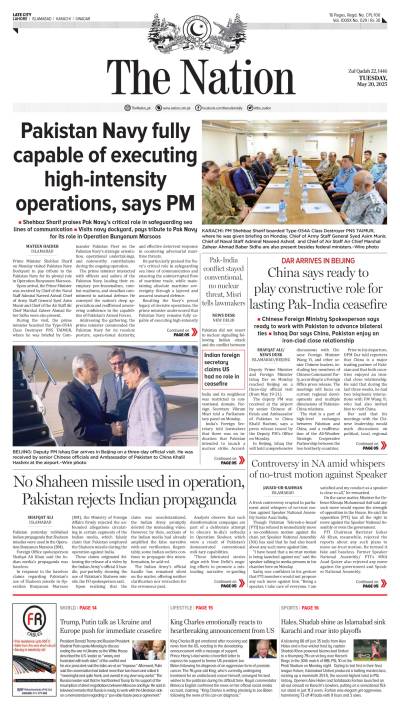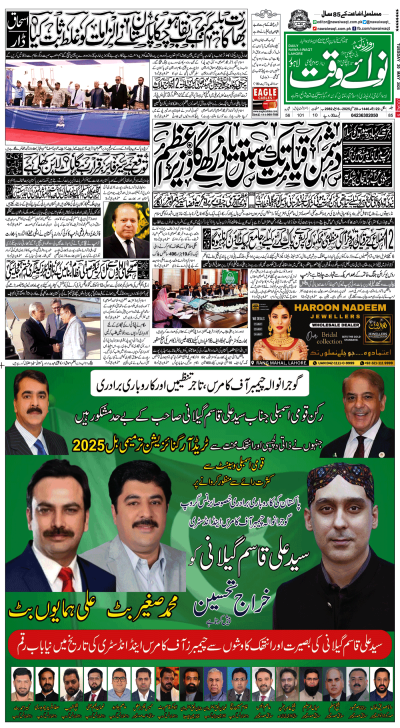GUEST WRITER
NASIM YOUSAF
On March 19, 1940, police opened fire on the Khaksars in Lahore, killing a number of them and wounding many others. Five days later, the All-India Muslim League passed the Pakistan and Khaksar Resolutions during its historic session in Lahore.
As we mark the 67th anniversary of the massacre, it is important to take a look back at the events that led up to the shooting - they leave no doubt that the Khaksars who gave their lives on that fateful day in 1940 were no less than martyrs who made the ultimate sacrifice for their nation. There were a number of reasons behind the clash.
During late 1930s, the Khaksar Tehrik had emerged as an incredibly powerful organisation in the Indian subcontinent. Its strength was revealed in 1939 during a clash with the government of UP, over the Sunni-Shia riots in Lucknow.
Fearing the Tehrik’s growing popularity, anti Khaksar elements attempted to suppress the movement. Punjab premier Sikandar Hayat Khan (also member of the Working Committee of the All-India Muslim League) who opposed the Khaksars, with the support of the anti Khaksar elements, took the first step towards banning the Khaksar Tehrik.
On Feb 22, 1940, the Punjab police raided Mohammadi Steam Press (printer of the Khaksar weekly, Al-Islah) in Lahore and confiscated copies of the Al Islah along with printed Khaksar materials and pamphlets.
Within a few days of this raid (on Feb 28), the Punjab government issued a Press Communique (under the Defense of India Rules), according to which Khaksar activities were banned. Allama Mashriqi, the founder and leader of the Khaksar Movement, was stunned by the government’s order. He launched immediate efforts - including meeting with Quaid-e-Azam and other prominent leaders - in an attempt to get the ban removed.
According to veteran journalist Syed Shabbir Hussain’s book - The Disowned Genius - Quaid-e-Azam told Mashriqi: “I wish Sikandar could be my man. If it had been so I would have ordered him.”
Fatima Jinnah, also present at the meeting, supported Mr Jinnah and agreed that “Sikandar is not our man.”
Despite Mashriqi’s efforts, however, the ban remained intact.
On March 19, a contingent of 313 Khaksars (from Punjab, Frontier and other provinces), dressed in military-style uniform with spades on their shoulders, came out on the streets of Lahore. They began a peaceful protest march towards Badshahi Mosque, where they were to offer prayers. The government officials also arrived at the site. Equipped with guns, pistols, batons, and shields, they intercepted the Khaksars and ordered them to stop the march, but the Khaksars continued.
According to renowned journalist Muhammad Saeed’s book - Lahore: A Memoir - Police superintendent D Gainsford “slapped Inayat Shah [Khaksar] in the face”. The situation quickly escalated and resulted in a serious clash between the police and the Khaksars. The police began indiscriminately firing on the defenseless Khaksars; it would not be wrong to state that this was a battle of guns versus spades.
The police’s arbitrary and ruthless firing continued for a considerable length of time. Many Khaksars lost their lives while a number of others were seriously injured.
In his book Friends and Foes, KL Gauba (then member of the Punjab Legislative Assembly) writes some 200 Khaksars were killed (though the government version only declared 32 killed).
Immediately after the massacre, the Khaksar headquarters (adjacent to Mashriqi’s house) were raided by police and army soldiers. Mashriqi, who was in Delhi at the time, was arrested as well.
Following the events of March 19th, the city was essentially operating under emergency laws; the government imposed a curfew, censored the news, and banned public processions and speeches.
Shops were closed and section 144, which prohibited the gathering of five or more persons in any street, lane, or public place (within the limits of the Lahore Municipality) was enforced.
News of Mashriqi’s arrest and the Khaksar killings spread like wildfire and sent shockwaves through British India. However, the All-India Muslim League (AIML) session scheduled for March 22-24, 1940 was not postponed. In fact, Sikandar Hayat Khan removed Section 144 in order for the Muslim League to hold its session.
The session thus began just three days after the brutal massacre of the Khaksars; this gathering would prove to be a historic one.
On March 22, the session started in Lahore with Sikandar Hayat Khan and other leaders in attendance. At the venue, large crowds outraged by the brutal massacre of the Khaksars just a few days earlier were present in order to seek redress for their grievances.
Sikandar and others made desperate efforts to prevent discussion of the Khaksar issue at the session. However, the angry and emotionally charged public at the site ignored Sikandar’s wishes and highly condemned the Punjab government.
They demanded an inquiry into the March 19th incident and compensation for murdered and injured Khaksars, the release of Mashriqi and the Khaksars, and lifting of the ban on the Khaksar Movement. They also pushed for the removal of Sir Sikandar from the Muslim League.
To avoid any untoward incident, Quaid-e-Azam, Liaquat Ali Khan, Nawab Bahadur Yar Jung (also a Khaksar), and other AIML leaders had to speak to the public at various occasions. Finally, owing to the public pressure, the AIML passed the Khaksar Resolution side by side with the Pakistan Resolution on the last night of the session (both resolutions were passed on March 24, 1940 and not on March 23, as is the common belief).
The atmosphere remained extremely tense throughout the entire three-day session. Unfortunately, the public’s support for the Khaksars during this three day session has been ignored, twisted, or inadequately incorporated in the history books of the Indian sub-continent for political reasons.
Although the March 19th massacre was a major turning point for independence, the Khaksar struggle did not end there. The events that unfolded following this incident tell the story of the longest, toughest, and most unparalleled fight against British rule in the Indian subcontinent.
There is no doubt that the tragedy united the nation and set the stage for freedom. Unfortunately, due to political implications and the controversial nature of the subject, the Khaksar Tehrik’s role is not discussed much in India or Pakistan.
Furthermore, despite their long struggle, some do not even consider the Khaksars who died on March 19th to be martyrs. It is time that we rise above political controversies and correct our history by acknowledging the role of the Khaksars.





